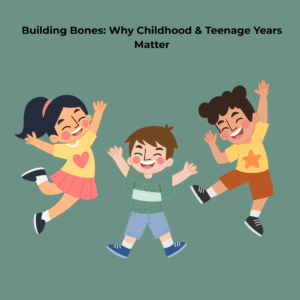Building Bones: Why Childhood & Teenage Years Matter
Building Bones: Why Childhood & Teenage Years Matter
Why Childhood and Teenage Years Matter Most for Bone Health
When we think of strong bones, most people focus on older adults and preventing osteoporosis—but the real foundation is built decades earlier.
Bones grow rapidly during childhood and adolescence, and most of your bone density is set by your mid-20s. In fact, by the time you’re 18, you’ve built about 90% of your adult bone mass.
This means what kids eat, how they move, and even how much sunshine they get during these years can shape how strong (or fragile) their skeleton will be later in life.
If you’re a parent, grandparent, or educator—or even someone looking back and wondering what you could have done differently—this information is critical.
🧱 Bone-Building Is Like Saving for Retirement
Think of building strong bones like filling a “bone bank.” You’re making deposits during your youth to protect against future withdrawals (like bone loss during menopause or aging).
More deposits early = more reserves later = less risk of fractures and pain down the line.
Peak bone mass is usually reached around age 30. After that, it’s mostly about maintenance. So if we don’t build enough during the growth years, we start the second half of life with less in the tank.
🧒 The Three Bone-Building Essentials for Kids & Teens
Here’s what’s needed to create strong bones during the growth years:
1. Weight-Bearing Exercise
Kids and teens need to move—not just any movement, but the kind that loads the skeleton. This stimulates bone-forming cells (osteoblasts) and increases density.
Best activities:
- Running
- Jumping
- Climbing
- Team sports (netball, basketball, soccer)
- Gymnastics or martial arts
Pro tip: Screen time doesn’t count. Encourage at least 60 minutes of active movement daily.
2. Calcium and Vitamin D
Bones are made of minerals, and calcium is the most important. But without vitamin D, calcium can’t be absorbed effectively.
Good calcium sources:
- Dairy (milk, cheese, yoghurt)
- Leafy greens (bok choy, kale)
- Tinned fish with bones (sardines, salmon)
- Fortified plant milks
Vitamin D is made in the skin from sun exposure, but with indoor living and sunscreen, many kids are deficient. A short daily burst of sun and/or supplementation may help—speak with your GP.
3. Posture & Spinal Health
Kids carry heavy bags, slouch over phones, and sit for hours at school. Over time, these habits can affect spinal alignment and load-bearing posture—especially during growth spurts.
As chiropractors, we often see teens with:
- Rounding shoulders
- Forward head posture
- Early signs of back or neck discomfort
Addressing these issues early helps bones grow in better alignment—and prevents problems later.
🧠 The Bigger Picture: Building Bone Habits Start Young
If a child grows up moving often, eating well, and caring for their posture, these habits usually stick. But if the early years are filled with inactivity and poor nutrition, the risk of future spinal, joint, and bone problems skyrockets.
✅ What Can You Do? Three Action Steps Today
- Encourage Movement Over Sitting
Whether it’s play, sport, or walking to school—get kids moving daily. Even 15-minute activity bursts add up. - Audit the Lunchbox
Is it rich in calcium and bone-friendly nutrients? Swap out sugar-laden snacks for yogurt, cheese, leafy greens, or tinned salmon. - Book a Spinal Check-Up for Your Child or Teen
We can assess posture, spine alignment, and detect early signs of strain from schoolbags, sports, or tech posture.
🙌 It’s Never Too Early (or Too Late) to be Building Bone
Even if your child hasn’t had the perfect bone-building childhood, today is always the best time to start.
And for adults? Stay tuned—we’ll be talking about how bones change through the decades in upcoming posts, including how menopause and age affect your skeleton.
Want to help your child build stronger bones for life? Book a spinal check-up today with one of our experienced chiropractors. It’s a simple step toward better lifelong posture, strength, and mobility.
